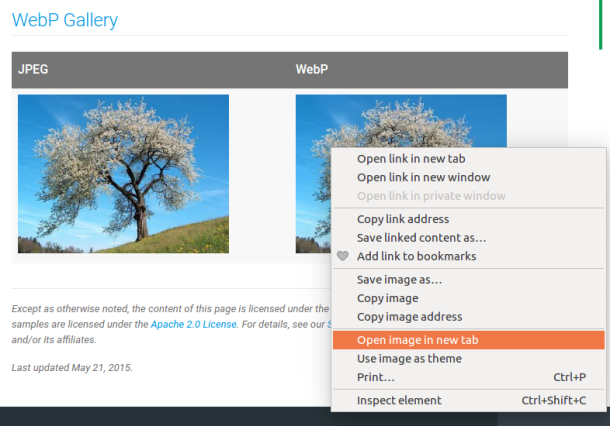Is my site serving WebP images? How to run a WebP test
We assume that you already learned about the WebP image format Google created. You generated WebP versions of your files with a smart tool – we assume that it was ShortPixel 🙂 And, finally, you employed a plugin (like wp-webp or why not, the same ShortPixel!) to deliver the WebP images to users who visit your site from a WebP-compatible browser (mainly all except IE and Safari; a full list is to be found here).
What’s next? Of course, you want to test if everything works as expected. The easiest method to see if your website has WebP images has three simple steps:
Step 1: Open your site in Chrome browser.
Step 2: Right-click on an image and choose Open in new tab.

Step 3: Check the image extension.
If it is .webp, then we can only congratulate you. And Google will love your site a bit more!
![]()
How to generate WebP images with ShortPixel
ShortPixel freely generates WebP files if you optimize your images with our WP plugin, and you have checked WebP versions option in ShortPixel Settings – Advanced section:
![]()
ShortPixel also has an option to deliver the WebP files for you, so you don’t need to look for another plugin out there to do that. Right under the previous option, you will find this:
For more info about how to create and use WebP images, please read this ShortPixel blog article: How WebP images can speed up your (WordPress) site.
Note: Starting May 10th 2021, the generation of WebP images files will cost 1 credit per .webp file. For more information, please consult this article.
Furthermore, ShortPixel has another excellent plugin called ShortPixel Adaptive Images, which helps you deliver WebPs even easier! Here’s a couple of articles to help you understand how ShortPixel AI works:
– Step-by-step guide to install and use ShortPixel Adaptive Images (SPAI)
– ShortPixel Adaptive Images vs. ShortPixel Image Optimizer
And a few more resources:
– Google: A new image format for the Web
– Smashing Magazine: Using WebP Image Format Today
Great, you know more about WebP format than some SEO specialists! Now, all you have to do is run a WEbP test on your website!
WebP – to use or not to use?
If your SEO is almost an unhealthy obsession, then you surely need WebP images 🙂 For the rest of the folks, the answer is Maybe. The ability to serve WebP files is a nice to have feature from a SEO point of view.
There is a “but”: please remember that WebP is not a universal format. Safari and Internet Explorer don’t understand it, and you need enough hosting storage to keep JPEG/PNG versions of your images alongside the WebP ones. Moreover, you depend on a caching or special plugin to deliver the right images to the right browsers.
More storage and more plugins, this is the price for having WebP files. You should decide whether it’s worth it. The good news is that ShortPixel can freely generate the WebP version of your images and at the same time, compress your pictures. It is not bad to have your JPEG/PNG images optimized alongside WebP 🙂
What image format does ShortPixel.com use?
ShortPixel’s preferred formats are: PNG for screenshots & logos, and JPEG for the rest of the images. Of course, SEO is important for us too. That’s why we developed Lossy optimization, which generates compressed images at a very good quality, and Glossy optimization for images looking almost identical with the originals.
Right now, we use Glossy*, because we want to have optimized images with the best picture quality, instead of stretching a few more bits for Google.
*You could read more about the new ShortPixel image optimization algorithm for photographers here: Glossy, image optimization option for photographers.